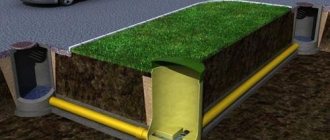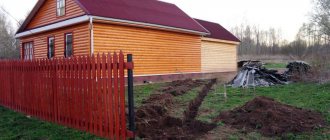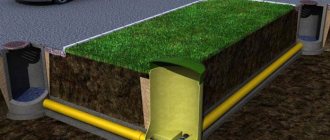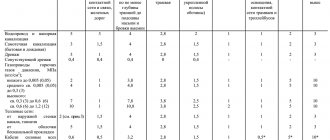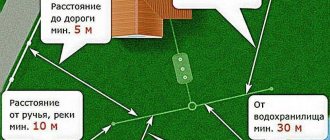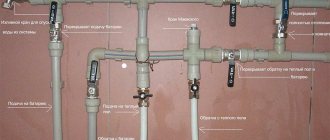The minimum distance from the septic tank to the neighbor’s fence according to SNiP, SanPiN and law. How many meters do you need to retreat on sections of SNT and individual housing construction? At what distance from the neighbor's fence can a septic tank be installed? A sewer system is a necessity in a private home and country house. When starting its construction, you need to determine the minimum distance from the septic tank to the neighbor’s fence and buildings in accordance with SanPiN and SNiP (SP) standards. You need to take into account the type of cesspool, type of soil, distance from the well and other inputs. In addition to the stench, sewer water can contaminate the soil and cause the death of shrubs and plants.
Not far from the neighbor's fence
Rules and regulations
If the septic tank is located incorrectly and the rules for constructing a sewer system are not followed, the waste can cause harm to nature, people living on the site, as well as their neighbors. Depending on the type of drainage pit and the category of the site, it is necessary to calculate the distance from the septic tank to the neighbor’s fence and residential building according to the standards:
- SP 53.13330.2019;
- SNiP 2.04.04-95 “Sewerage”;
- SNiP 2.04.04-94 “Water supply”;
- SanPiN 2.1.5.98-00.
Location on
Having determined a place for a septic tank on your site, you need to obtain permission to build it from the local sanitary inspection. In addition to the plan of the site itself, bordering reservoirs, rivers, water supply systems and the location of gas systems should be indicated before construction.
If the distance from the septic tank to the facility differs in different documents, the greatest distance must be maintained.
When septic tanks leak, they pose a considerable danger from the point of view of soil and water contamination. Based on this, fire safety standards allow a shorter distance from the fence to the septic tank than SanPiN standards.
Choosing a site for a cesspool
The distance from the cesspool to the well is not the only norm of SanPiN and SNiP, the fulfillment of which is required by law when constructing a sump. On the territory of a private household, you need to choose a site for placing a pit so that the following nuances are taken into account:
- the distance from the water supply line is no shorter than 1 m;
- distance from a shaft-type well – 20 m;
- the distance to the well is no shorter than 30 m;
- distance to buildings (including neighboring ones) - at least 10 m;
- the distance from the site fence is not shorter than 1 m;
- the presence of a spacious access road to the pit for a sewer truck.
Septic tank options
When planning to create a sewer system in a house, it is necessary to immediately design a local treatment system. It is important to position the septic tank correctly so that all standards are met and met. It is necessary to calculate the volume of wastewater and select the appropriate VOC design.
Layout at the dacha
For a summer house with temporary accommodation for up to 4 people and a shower in the bathroom, a single-chamber sump tank with a bulk bottom is suitable. Filtration will be carried out through it and some of the water will come out. It will be enough to pump out the contents from it once a season.
On soils with groundwater close to the surface, a tank with a solid bottom or concrete rings stacked on top of each other with a cushion at the bottom will be optimal. Under them you need to dig a hole 4 m deep with a layer of clay below. You will have to pump out water from such a waste collector more often, once every 3–5 months, but there will be a guarantee that the water in the well will not become contaminated.
For a house with a bathroom and several sinks, a kitchen sink and other equipment, a model with an overflow and biological water purification or disposal through an aeration field is required. The water at the output of such a device can be used as technical water: to water the garden, wash the car, paths and the facade of the house. Maintenance frequency – sludge cleaning 1–2 times a year.
The common village latrine and cesspool belong to another category of disposal devices. The distance to it from the fence according to SNIP (SP) is much greater.
Material requirements
The following are most often used for constructing cesspools:
- Concrete and reinforced concrete rings. Ready-made perforated products are used to install a well with drainage through the walls and bottom. The connection is made using factory locks or a sealing compound. At the top, a sealed lid and a ventilation outlet must be installed.
- Brick. The laying is carried out on a mortar with the creation of filter slots to drain liquid into the ground.
- Plastic. Installation of a polymer tank is the optimal solution for a sealed cesspool. The walls of the products consist of several layers, which reduces the likelihood of freezing and cracking. Their service life is up to half a century.
The factory-made storage kit includes a sealed lid, internal steps for maintenance, a ventilation outlet in the upper part, and a pipe for connecting the pipeline. The containers are available with smooth walls, which makes cleaning easier.
Distance from septic tank
A septic tank is a container sealed on the sides. When determining a safe distance, the possibility of cracks forming and the contents of the drain container leaking out into the ground through them is taken into account. In this case, contamination of natural reservoirs and drinking water sources may occur.
Standards for the placement of buildings on individual housing construction and SNT sites
Fence distance
At what distance a septic tank can be installed from the fence is determined by the category of the site. On SNT territory, a model with two closed chambers can be installed 1 meter from a neighbor’s fence if there is a centralized water supply. As a rule, people do not live permanently in a garden community (at a summer cottage), hence the amount of wastewater is insignificant.
In rural areas, individual housing construction plots are determined taking into account the installation of a septic tank of any type, in addition to a cesspool, at a distance of 2 m from the neighbors’ fence. The main standards that should be followed are SP 53.13330.2019 (formerly SNiP).
Installing a sump tank in a dacha near a neighbor's fence
When using an absorbent platform for final cleaning and disposal of light wastewater, it should be located at a distance of 2 m from the neighbor’s fence and 5 m from the underground pipeline.
A distance of 2 meters from the neighbor’s fence is the required SanPiN norm.
Cleaning of sludge and solid sediments should be carried out regularly, in accordance with the technical data sheet or as waste accumulates. It is not recommended to plant fruit trees, shrubs, and vegetable crops over soaking fields. You can plant a flower garden and equip a lawn.
From the front fence, the ebb is mounted at a distance of 5 m. The distance is measured from the front boundary of the site, regardless of the location of the fence and the passage of the red line. The distance to communications located underground must be at least 5 m.
On the side of the road, it is necessary to determine free passage for the sewer truck, even if an aeration field is equipped. It is necessary to periodically pump out the contents of the first container when it is full.
If there is an alley on the side, then there should be a gap of more than 5 meters from the curb of the road to the septic tank. In this case, the distance from the septic tank to the border of the site should be maintained at least 2 meters, regardless of the location of the fence relative to the roadway.
Distance to residential building
The location of the septic tank relative to the house is determined by several factors:
- Extension of external sewerage.
- Water getting under the foundation.
- Possibility of repulsive odors.
Layout according to SNiP and SanPiN standards
According to GOST for the construction of sewers in a private house, the slope of the pipes must correspond to 2 degrees. When the slope is not maintained, waste will stand and form blockages. At a great distance, the entrance to the container will be low and will have to be buried in the ground.
According to SNiP, the distance of the septic tank from the house must be at least 5 meters. This distance between the building and the sump ensures that if the tank breaks, moisture will not flood the foundation. During operation, the smell will not reach the windows of a residential building.
According to building regulations, it is recommended to install a septic tank no further than 10 m from the entrance to the house. This means that the optimal removal of the tank for cleaning and settling sewage is within 5–10 meters from the point where the sewer pipes exit from the foundation of the building.
The septic tank should be located at a distance of 8 meters from the neighbor’s house. It must be measured in a straight line between the nearest points.
The distance from the barn with birds and small animals can be kept minimal, 1 meter. The same distance from a greenhouse, bathhouse or garage.
Underground water sources
Sewage can penetrate long distances underground and cause water pollution. According to sanitary standards, a protective zone is created from bodies of water with standing or running water.
Subtleties of the location of buildings according to SP (SNiP)
Regardless of the model, the septic tank should be located at least 50 m from lakes. From flowing bodies of water: rivers, streams - no closer than 30 m. The sanitation station may prohibit installing a septic tank at a minimum distance if it is located significantly above the water level on a slope.
How long should you retreat from the well?
GOST regulates the standard location of the septic tank. You should take into account not only the distance from the neighbor’s fence to the septic tank on the site, but also how much to retreat relative to various sources of drinking water. In case of infection, in addition to the terrible smell and taste, the water may contain helminths, pathogens of serious diseases and substances harmful to human health.
Scheme at the dacha
With centralized water supply and in the case of supplying water from a well and a well, the septic tank should be located at a distance of 10 m along the shortest straight line between objects. It is not allowed to cross underground water and sewer pipes at different levels.
A deep-water well supplying water from the second water layer and below is made at a minimum distance of 25 m. When issuing a permit for the construction of a wastewater treatment system, the controlling organization studies geodetic survey data, the location and composition of soil layers. They may recommend another site for construction and base their claim on voids or loose rocks.
A well and a shallow water intake well, supplying water from the first layer from the soil surface, must be 50 meters away from the septic tank. If effluent leaks, it must be completely cleared on its way to the well.
Which government agencies can control sewerage in a private home?
Sewage belongs to the engineering systems of buildings. This also includes water, gas and electricity supply. For each of the last three systems, a certified project is required. To carry out a private sewerage system (not connected to the central system), a project is not needed in most regions.
Perhaps this is why most property owners install sewerage in a private house on their own: someone wins from this, but there are also those who lose. Mistakes in installing a septic tank yourself often lead to sad consequences: violation of sanitary zones, flooding of areas and the appearance of unpleasant odors.
If the above problems occur, neighbors may complain about you to any regulatory authority, which, in turn, will forward the problem to the right address - for example, to the Sanitary and Epidemiological Service (SES) or the Environmental Prosecutor's Office. It is these two bodies that most often inspect private sewers. In addition, the SES will be especially interested in the state of affairs on your site if it is located in a water protection zone.
If there is a swimming pool on the site, a drainage inspection can be carried out by the local Vodokanal service. It is believed that when constructing a private swimming pool, the choice of its technological scheme must be made in accordance with wastewater disposal standards agreed upon with the water supply and sewerage system.
Subtleties in the rules for septic tank location
You can start digging a hole and installing a septic tank after permission has been received. By law, a minimum distance is maintained to all sources of water, your own and your neighbors. The rules for the location of the septic tank must be strictly observed.
Construction at the dacha
When receiving permission to develop a site, the architecture department and sanitary supervisory authorities check the layout of the house and utility rooms on all adjacent plots.
They double-check the availability of water sources. If the minimum setback from the required points is observed, a building permit is issued.
If there is nothing nearby or construction behind the fence has not begun, or more precisely, permission has not yet been issued, you can maintain a distance in compliance with sanitary standards only from your house and well. It is enough to retreat 1 m from the side border of the site, the fence.
The garage belongs to the category of ancillary buildings. Sanitary standards allow the installation of a septic tank at a distance of 1 m from it. Unlike sheds, a permanent strip foundation is made for the garage. If there is an inspection pit, experts recommend retreating at least 2 m so that wastewater does not wash away the base of the building and penetrate into the pit and basement.
Is it possible to make a smaller indentation from the fence and, in agreement with the neighbor, symmetrically place sedimentation tanks at a distance of 1 m on both sides of the fence? A building permit will have to be issued at the same time. Both owners of the site indicate in a statement of joint agreement and their consent to such deviations from the norms.
Environmental measures
More and more attention in the modern world is paid to nature conservation. The distance of sedimentation tanks from reservoirs according to sanitation standards is increasing, as well as their distance from sources of running water. According to old data, this distance was 8 m. Now, in accordance with the requirements, any storage septic tank, toilet, VOC can only be located at a distance of at least 30 m from the water source. A minimum distance of 15 m between deep wells is also observed, provided that the density and thickness of the soil lying between them guarantees complete water purification.
Permission is issued by the local administration and SES
Before building a fence, its plan must be approved. Fences greater than 1.5 m in height are prohibited. Also, between the plots you can only make a transparent fence that does not shade the garden.
Scheme option
Distance from the property line to the septic tank
Installation of sewerage in a village is often carried out during the development of individual housing construction sites. In other cases, for summer living, a toilet such as a closet is installed outside or all wastewater from the house is directed to a cesspool.
Installation of equipment
Since they are not made airtight, they, like compost pits, have completely different, more stringent requirements for disposal according to sanitary standards:
- side and rear fence from the neighboring plot - 4 m;
- from a residential building – 8 meters;
- from the edge of the forest – 20 m;
- from the gas pipeline – 5 meters;
- from the front border - 8 meters;
- from the side road – 5 m;
- to the barns and utility block - 1 meter.
There are several regulatory documents regarding the location of the cesspool. There are some numbers in them that do not match. Each region adheres to its own standards. For example, the distance from the windows of a neighbor’s house is determined to be at least 12 m.
The recommended distance from the neighbor's fence is 5 m. You can avoid misunderstandings and controversial issues by contacting the local government in the village or the supervisory department of architecture within the city.
SNT, DNO and other cooperatives and societies may have their own schemes and development plan, indicating the location of greenhouses, cesspools, toilets and greenhouses. They are at odds with building codes and SanPiN. The small size of the plots does not allow maintaining a distance to sources of drinking water. Wells can be for public use and placed beyond the front boundary of the fences.
With centralized water supply, simultaneous placement of cesspools in adjacent areas is possible. Which and where it may be located is indicated on the general plan of the cooperative’s lands. At the same time, the requirement of free passage for a sewage disposal truck on a summer cottage or garden plot is observed.
In IPH, the basis is barns for keeping animals. In this case, cesspools could be located almost under the walls of the barn from which they would be filled. The building can be located at a distance of 1 meter from the neighbor’s fence and 12 m from the house. The cesspool is located on the inside of the site to ensure a minimum distance from the fence and windows of your own and neighbors’ homes.
Permission
Before constructing a cesspool, you must obtain permission. For this purpose, the SES provides:
- Scheme of the location of the object on the site.
- The design of the structure, and it must comply with sanitary standards and regulations.
If documents are submitted that do not comply with the requirements of the law, permission will not be obtained.
But that’s not all, because after construction is completed and even several years later, an inspection inspector may come. In fact, the distance to the cesspool from the well and from other key points must correspond to the submitted documents. Inspectors do not conduct inspections at their own discretion; they often appear on a “tip” from neighbors.
Important! Do not neglect obtaining a permit; it will not cost much. You will have to stand in the corridors of the government agency, but it is cheaper than paying a fine if the distance from the well to the cesspool is incorrect.
It will be possible to obtain permission only if the cesspool is located not on the territory of a neighboring plot, but on your own. Moreover, it does not matter whether this (someone else’s) plot is residential or not and whether it is owned by someone.

